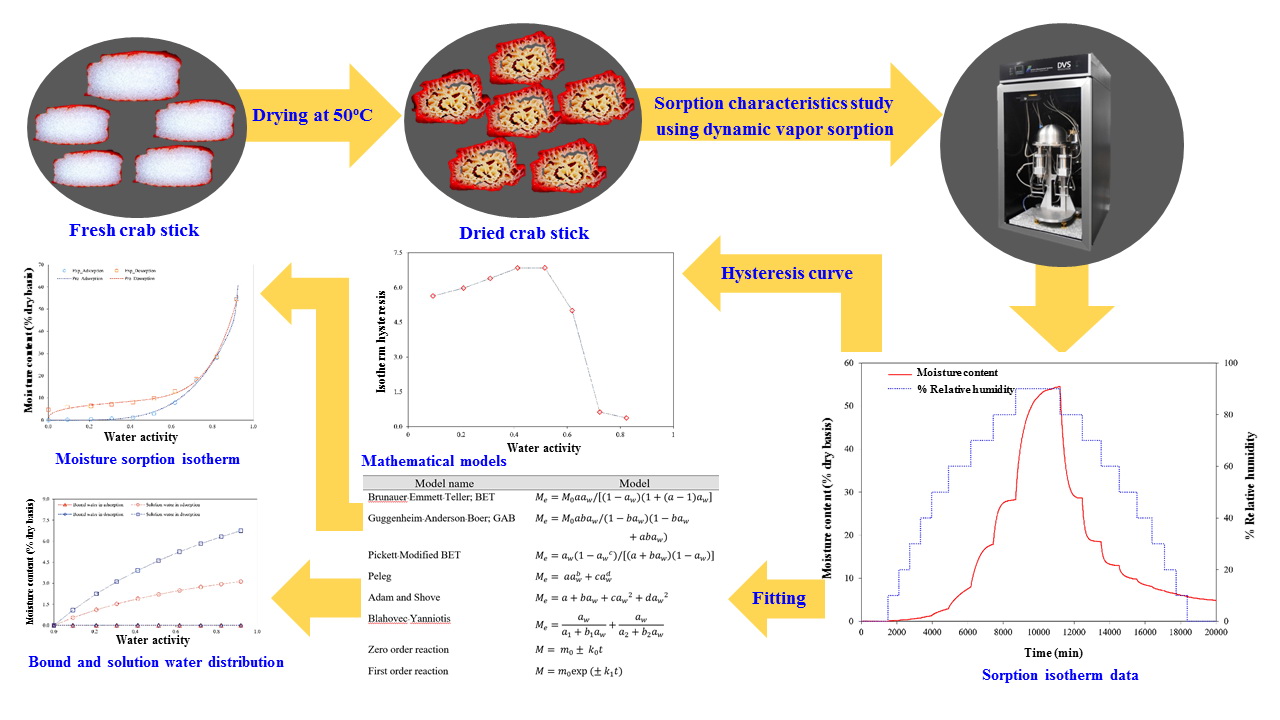The Study of Sorption Characteristics of Dried Crab Stick Product Using Dynamic Vapor Sorption
DOI:
https://doi.org/10.48048/wjst.2021.20593Keywords:
Crab stick, Dynamic vapor sorption, Mathematical modeling, Sorption isotherm, Sorption kineticsAbstract
The research delved into the sorption characteristics of dried crab stick products using dynamic vapor sorption (DVS). The obtained sorption isotherm data, including equilibrium moisture content (Me) and water activity (aw), were fitted with 6 different sorption isotherm models, such as Brunauer-Emmett-Teller (BET), Guggenheim-Anderson-Boer (GAB), Pickett-Modified BET, Adam and Shove, Blahovec-Yanniotis, and Peleg. The results showed that the Peleg model was the best-describing model with a coefficient of determination (R2), chi-square (χ2), root mean square error (RMSE), and standard error of estimate (SEE) ranging from 0.988 to 0.998, 0.719 to 4.349, 0.431 to 2.609 and 0.692 to 1.703, respectively. According to the classification of the shape of moisture sorption isotherm, the isotherm type III and II were found in this research for adsorption and desorption, respectively. The GAB and BET models were used to estimate monolayer moisture content (M0) of the sample and it was found that the M0 ranged from 3.65 to 5.36 % dry basis and 4.57 to 4.83 % dry basis for GAB and BET models, respectively. Blahovec-Yanniotis’s model was applied in this work to investigate the contribution of water and the result showed that the contribution of solution water played a major in the moisture changes of the sample during the adsorption and desorption process. Moreover, sorption isotherm data were modeled with 0 and 1st order reaction kinetics, and the results demonstrated that 0 order and 1st order models were the most appropriate model to describe moisture changes behavior of the sample at each relative humidity step for adsorption and desorption, respectively.
HIGHLIGHTS
- The construction of sorption isotherms of dried crab stick product using dynamic vapor sorption
- GAB and BET models were used to estimate monolayer moisture content
- Peleg model was the most appropriate model to describe sorption behaviors of dried crab stick product
- Blahovec-Yanniotis provided the contribution of water information of dried crab stick during adsorption and desorption processes
- The application of reaction order kinetics could provide the information of moisture changing behaviors at each relative humidity step for adsorption and desorption processes
GRAPHICAL ABSTRACT
Downloads
Metrics
References
Surimi Market update, Available at: https://surimitech123.com/wp-content/uploads/2019/10/1h-Surimi-Market-Update-September-2019-Surimi-Forum-Madrid-September-2019.pdf, accessed February 2021.
T Phahom, N Juntharat, P Premsuttarat, Y Paosunthia and G Roudaut. Evaluation of desorption isotherms, drying characteristics and rehydration properties of crab stick by-product. Heat Mass Transf. 2021; 57, 1039-52.
AH Al-Muhtaseb, WAM McMinn and TRA Magee. Moisture sorption isotherm characteristics of food products: A review. Trans. Ins. Chem. Eng. 2002; 80, 118-28.
S Brunauer, PH Emmett and E Teller. Adsorption of gases in multi-molecular layers. J. Am. Chem. Soc. 1938; 60, 309-19.
C Van den Berg and S Bruin. Water activity and its estimation in food systems. In: LB Rockland and GF Stewart (Eds.). Water activity: Influences on food quality. Academic, New York, 1981, p. 147-77.
G Pickett. Modification of the Brunauer-Emmett-Teller theory of multi-molecular adsorption. J. Am. Chem. Soc. 1945; 67, 1958-62.
M Peleg. Assessment of a semi-empirical four parameter general model for sigmoid moisture sorption isotherms. J. Food Process. Eng. 1993; 16, 21-37.
J Chirife and HA Iglesias. Equations for fitting water sorption isotherms of foods: Part 1-A review. J. Food Technol. 1978; 13, 159-74.
J Blahovec and S Yanniotis. Modified classification of sorption isotherms. J. Food Eng. 2009; 91, 72-7.
L Cervenka, J Kubinova, L Juszczak and M Witczak. Moisture sorption isotherms and glass transition temperature of elecampe (Inula helenium L.) and burdock (Arctium lappa L.) root at 25 °C. Food Sci. Technol. Int. 2012; 18, 81-91.
A Vega-Galvez, J Lopez, K Ah-Hen, MJ Torres and R Lemus-Mondaca. Thermodynamic properties, sorption isotherms and glass transition temperature of cape gooseberry (Physalis peruviana L.). Food Technol. Biotechnol. 2014; 52, 83-92.
ND Mrad, C Bonazzi, N Boudhrioua, N Kechaou and F Courtois. Moisture sorption isotherms, thermodynamic properties, and glass transition of pears and apples. Dry. Technol. 2012; 30, 1397-406.
CMD Man and A Jones. Shelf-life evaluation of foods. Aspen Publishers, Maryland, 2000, p. 1-24.
B Saberi, QV Voung, S Chockchaisawasdee, JB Golding, CJ Scarlett and CE Stathopoulos. Water sorption isotherm of pea starch edible films and prediction models. Foods 2006; 5, 1.
E Ayranci and O Duman. Moisture sorption isotherms of cowpea (Vigna unguiculata L. Walp) and its protein isolate at 10, 20 and 30 °C. J. Food Eng. 2005; 70, 83-91.
CE Chinma, CC Ariahu and J Alakali. Moisture sorption and thermodynamic properties of cassava starch and soy protein concentrate based edible films. Int. J. Food Sci. Technol. 2013; 48, 2400-7.
G Aguirre-Alvarez, T Foster and SE Hill. Modelling of isotherms and their hysteresis analysis in gelatin from different sources. CyTA J. Food. 2013; 11, 68-74.
Y Singh and K Prasad. Sorption isotherms modeling approach of rice-based instant soup mix stored under controlled temperature and humidity. Cogent Food Agric. 2015; 1, 1-11.
P Khawas and SC Deka.Moisture sorption isotherm of underutilized culinary banana flour and its antioxidant stability during storage. J. Food Process. Pres. 2017; 41, 1-10.
DR Heldman and DB Lund. Handbook of Food Engineering. Marcel Dekker, New York, 1992, p.653-687
JG Kapsalis. Influences of hysteresis and temperature on moisture sorption isotherms. In: LB Rockland and LR Beuchat (Eds.). Water activity: Theory and applications to food. Marcel Dekker, New York, 1987, p.173-213.
M Kouhila, A Belghit, M Daguenet and BC Boutaleb. Experimental determination of sorption isotherms of mint (Mentha viridis), sage (Salvia officinalis) and verbena (Lippia citriodora). J. Food Eng. 2001; 47, 281-7.
LB Rockland.The practical approach to better low moisture foods: Water activity and storage stability. Food Technol. 1996; 23, 1241-9.
I Doymaz. Mathematical modeling of drying of tomato slices using infrared radiation. J. Food Process. Pres. 2014; 38, 389-96.
Downloads
Published
How to Cite
Issue
Section
License

This work is licensed under a Creative Commons Attribution-NonCommercial-NoDerivatives 4.0 International License.













